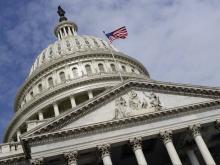
Agricultural News
EWG Urges Lawmakers to Reject 'Farm Bill Bait and Switch'
Fri, 10 May 2013 16:43:54 CDT

The following is an editoral from the Environmental Working Group written by Craig Cox, Senior Vice President for Agriculture and Natural Resources and Scott Faber, Vice President of Government Affairs:
Here's the bottom line: Both farm bills proposed this week (May 13) by the House and Senate Agriculture committees would cut funding for the hungry and the environment to help boost subsidies for the largest and most successful farm businesses.
That's despite the fact that farm income is near record highs and the average household income of a large commercial farm is more than $200,000 a year.
That's despite the fact that America's rivers are polluted with fertilizers and pesticides and farmers have plowed under more than 23 million acres of wetlands and prairies since 2008 - an area the size of Indiana.
That's despite the fact that 47 million Americans - including millions of children - are depending on anti-hunger programs in a sluggish economy.
Both the House and Senate proposals increase subsidies in two ways: by allowing farmers to buy even more federally subsidized crop insurance and by increasing price guarantees for certain crops.
Taken together, the new subsidies will further tilt the playing field in favor of the largest farmers, increase the cost of farm subsidies to taxpayers and create new incentives for farmers to plow up even more wetlands and prairies.
Under current law, taxpayers already subsidize crop insurance in three ways: by paying two-thirds of a farmer's premium; by paying companies $1.3 billion a year to sell insurance; and by paying most of the claims when crops fail. Altogether, the cost of crop insurance has ballooned from $2 billion in 2001 to more than $9 billion a year now. Both the House and Senate bills further sweeten this already sweet deal by subsidizing farmers to buy "supplemental coverage" and by providing an especially generous insurance subsidy to cotton farmers.
By contrast, the Senate bill cuts $4 billion from the Supplemental Nutrition Assistance Program (SNAP), the House bill cuts it by more than $20 billion, and both bills cut voluntary USDA conservation programs by more than $5 billion.
Clearly, this is the time to cut subsidies, not fatten them.
In 2000, Congress doubled insurance premium support and created new subsidies for insurance companies to get more farmers to buy their policies. That problem has been solved, and Congress could, and should, gradually reduce subsidy rates and ask farmers to share more of the cost of risk management.
By doing so, Congress could generate about $40 billion in savings over the next decade - more than enough to meet deficit reduction targets without shorting the hungry or the environment. Other reforms, such as payment limits on premium support and reducing subsidies to insurance companies, would also generate significant savings.
Instead, the House and Senate proposals would continue to provide unlimited insurance subsidies to the largest farms.
In 2011, 26 policyholders received more than $1 million each in premium support to buy crop insurance and roughly 10,000 policyholders received more than more than $100,000 each. The bottom 80 percent, meanwhile, got just $5,000 each to help them buy coverage.
Both bills finally end direct payments. And thanks to the leadership of Chairwoman Debbie Stabenow (D-Mich.), the Senate bill does include important new investments in programs to help link local farmers with consumers and to promote healthier diets.
But these small investments pale in comparison to the new subsidies provided to the largest and most successful farmers. Most of the savings achieved by ending direct payments are plowed back into unlimited insurance subsidies and new price guarantees.
Congress should reject this cynical bait and switch, support real reforms to the badly bloated crop insurance program and reject cuts to programs designed to help the hungry and the environment.
WebReadyTM Powered by WireReady® NSI
Top Agricultural News
More Headlines...




















